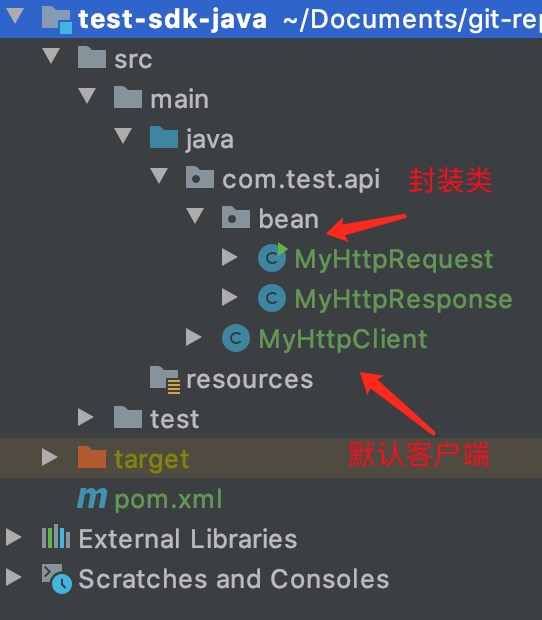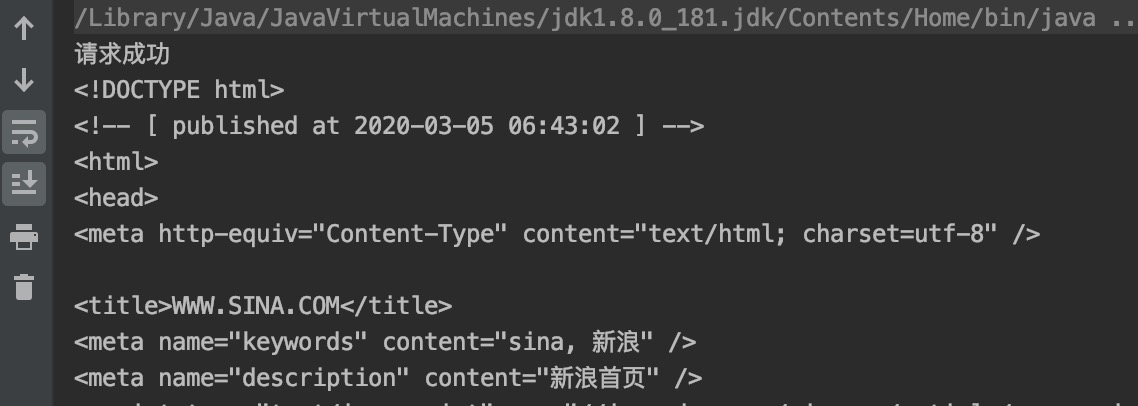前提
实际上开发一个Java-SDK的过程,实际上也就是开发一个基本java项目并打包成jar包的过程,然后可以被其它项目引入使用。
开发Java-SDK
本例介绍开发一个向某一数据接口发送请求并返回结果的SDK
1、新建一个Maven工程test-sdk-java

2、编辑pom文件,引入需要的jar包,若不需要第三方jar包也可以不引入
本例使用了hutool工具包
1 <?xml version="1.0" encoding="UTF-8"?> 2 <project xmlns="http://maven.apache.org/POM/4.0.0" 3 xmlns:xsi="http://www.w3.org/2001/XMLSchema-instance" 4 xsi:schemaLocation="http://maven.apache.org/POM/4.0.0 http://maven.apache.org/xsd/maven-4.0.0.xsd"> 5 <modelVersion>4.0.0</modelVersion> 6 7 <groupId>org.example</groupId> 8 <artifactId>test-sdk-java</artifactId> 9 <version>1.0-SNAPSHOT</version> 10 11 <dependencies> 12 <dependency> 13 <groupId>cn.hutool</groupId> 14 <artifactId>hutool-all</artifactId> 15 <version>5.3.7</version> 16 </dependency> 17 </dependencies> 18 19 </project>
3、编辑封装类,可以封装一些必要的逻辑
MyHttpRequest.java
1 package com.test.api.bean; 2 3 import cn.hutool.http.HttpRequest; 4 import cn.hutool.http.HttpResponse; 5 6 public class MyHttpRequest { 7 8 private HttpRequest httpRequest; 9 10 public MyHttpRequest(String url){ 11 httpRequest = HttpRequest.get(url); 12 // 可以封装其他逻辑 13 } 14 15 public MyHttpResponse execute(){ 16 if(httpRequest == null) { 17 throw new NullPointerException("httpRequest is empty !"); 18 } 19 HttpResponse httpResponse = httpRequest.execute(); 20 MyHttpResponse myHttpResponse = new MyHttpResponse(); 21 myHttpResponse.setHttpResponse(httpResponse); 22 return myHttpResponse; 23 } 24 25 public static void main(String[] args) { 26 MyHttpRequest myHttpRequest = new MyHttpRequest("https://www.sina.com"); 27 MyHttpResponse myHttpResponse = myHttpRequest.execute(); 28 int status = myHttpResponse.getStatus(); 29 if(status == 200) { 30 System.out.println(myHttpResponse.body()); 31 }else { 32 System.out.println("status === " + status ); 33 System.out.println("请求失败!"); 34 } 35 } 36 }
MyHttpResponse.java
1 package com.test.api.bean; 2 3 import cn.hutool.http.HttpResponse; 4 5 public class MyHttpResponse{ 6 7 HttpResponse httpResponse; 8 9 public HttpResponse getHttpResponse() { 10 return httpResponse; 11 } 12 13 public void setHttpResponse(HttpResponse httpResponse) { 14 this.httpResponse = httpResponse; 15 16 } 17 18 public int getStatus() { 19 if(httpResponse == null) { 20 throw new NullPointerException("httpResponse is empty !"); 21 } 22 return httpResponse.getStatus(); 23 } 24 25 public String body(){ 26 if(httpResponse == null) { 27 throw new NullPointerException("httpResponse is empty !"); 28 } 29 return httpResponse.body(); 30 } 31 }
4、编辑一个客户端MyHttpClient.java
1 package com.test.api; 2 3 import com.test.api.bean.MyHttpRequest; 4 import com.test.api.bean.MyHttpResponse; 5 6 public class MyHttpClient { 7 8 private static MyHttpClient myHttpClient; 9 10 /** 11 * @return Instance 12 */ 13 public static MyHttpClient getInstance() { 14 synchronized (MyHttpClient.class) { 15 if(myHttpClient == null) { 16 myHttpClient = new MyHttpClient(); 17 } 18 } 19 return myHttpClient; 20 } 21 22 public MyHttpResponse execute(String url){ 23 MyHttpRequest myHttpRequest = new MyHttpRequest(url); 24 return myHttpRequest.execute(); 25 } 26 27 }
5、打包
1)调用方是maven工程,调用时直接使用依赖引入的方法使用sdk
使用mvn命令:mvn clean install打包安装
2)调用方是非maven工程,调用时直使用 sdk jar包
需要使用其他方式打包:见【Java】Maven 打包可运行jar包
使用Java-SDK
1、新建一个Maven工程test-sdk-java-test
2、引入sdk依赖
1 <?xml version="1.0" encoding="UTF-8"?> 2 <project xmlns="http://maven.apache.org/POM/4.0.0" 3 xmlns:xsi="http://www.w3.org/2001/XMLSchema-instance" 4 xsi:schemaLocation="http://maven.apache.org/POM/4.0.0 http://maven.apache.org/xsd/maven-4.0.0.xsd"> 5 <modelVersion>4.0.0</modelVersion> 6 7 <groupId>org.example</groupId> 8 <artifactId>test-sdk-java-test</artifactId> 9 <version>1.0-SNAPSHOT</version> 10 11 <dependencies> 12 <dependency> 13 <groupId>org.example</groupId> 14 <artifactId>test-sdk-java</artifactId> 15 <version>1.0-SNAPSHOT</version> 16 </dependency> 17 </dependencies> 18 </project>
3、编写主类进行测试
1 public class MyMain { 2 public static void main(String[] args) { 3 // 配置 4 String url = "https://www.sina.com"; 5 // 获取SDK中客户端 6 MyHttpClient myHttpClient = MyHttpClient.getInstance(); 7 // 执行业务 8 MyHttpResponse myHttpResponse = myHttpClient.execute(url); 9 int status = myHttpResponse.getStatus(); 10 if(status == 200) { 11 System.out.println("请求成功"); 12 System.out.println(myHttpResponse.body()); 13 }else { 14 System.out.println("status === " + status ); 15 System.out.println("请求失败!"); 16 } 17 } 18 }
4、运行主类的主方法
